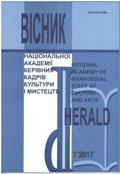АНАЛІЗ ПРИБУТКОВОСТІ ТВОРІВ МИСТЕЦТВА
FINE ART PROFITABILITY ANALYSIS
Author(s): Borys PlatonovSubject(s): Visual Arts, Marketing / Advertising, Business Ethics, Sociology of Art
Published by: Національна академія керівних кадрів культури і мистецтв
Keywords: artwork; investing; profit; the cost of bank deposit; risks; changes in the value of works of art;
Summary/Abstract: Purpose of Article. Among significant part of the society it is widely believed that investing in artwork is very effective, almost equivalent to monetary investment. The aim of the work is to check whether this is true. Methodology. Based on the model of cash deposit value growth in time, the author uses the method, well-known to appraisers, that allows to calculate the profit from movable property by analogy with the profit from a bank deposit. The basis for calculations is the data on the sale of the most expensive four paintings, as well as the averaged data on the sales of paintings published in some sources. Scientific novelty. The scientific novelty of the work lies in the fact that in determining the value the author has used the most effective option of profits for the calculation. However, it used very rarely. The mathematical model, used in the work has allowed to significantly simplify carrying out various calculations that in the end ensured mutual graphical interpretation of the results of the initial and top values of the values of paintings. Conclusions. The calculations showed that the idea of the equivalence of investing in artwork to monetary investing is in most cases incorrect. Only from a small percentage, no more than 15%, of the total weight of works, traded in the market, you can expect the efficiency of investing equivalent to monetary investing, and only about 4% of works over a long period after the creation (about 100 years) can become the world TOP of the most expensive ones.
Journal: Вісник Національної академії керівних кадрів культури і мистецтв
- Issue Year: 2017
- Issue No: 1
- Page Range: 86-90
- Page Count: 5
- Language: Ukrainian

